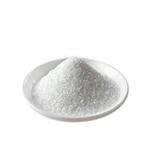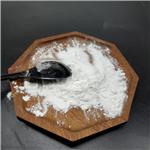- DL-Threonine
-

- $0.00 / 25Kg/Drum
-
2024-04-23
- CAS:80-68-2
- Min. Order: 1KG
- Purity: 99%
- Supply Ability: 200mt/year
- DL-Threonine
-

- $30.00 / 1kg
-
2024-04-22
- CAS:80-68-2
- Min. Order: 1kg
- Purity: 98%
- Supply Ability: 2000kg
- DL-Threonine
-

- $0.00 / 1kg
-
2023-08-04
- CAS:80-68-2
- Min. Order: 1kg
- Purity: 0.99
- Supply Ability: 500000kg
|
| | DL-Threonine Chemical Properties |
| Melting point | 244 °C (dec.)(lit.) | | Boiling point | 222.38°C (rough estimate) | | alpha | [α]D20 0±1.0゜ (c=6, H2O) | | density | 1.3126 (rough estimate) | | refractive index | 1.4183 (estimate) | | storage temp. | Store at RT. | | pka | 2.09(at 25℃) | | form | Powder | | color | White | | Water Solubility | 200 g/L (25 ºC) | | Merck | 14,9380 | | BRN | 1721647 | | LogP | -1.136 (est) | | CAS DataBase Reference | 80-68-2(CAS DataBase Reference) | | NIST Chemistry Reference | DL-Threonine(80-68-2) | | EPA Substance Registry System | Threonine (80-68-2) |
| | DL-Threonine Usage And Synthesis |
| Chemical properties | Because of the 2 asymmetric carbon atoms contained in the threonine molecule there are D-threonine, L-threonine, D-doxylthreonine and L-doxylthreonine, four kinds of optical isomers, of which the amino acids constituting the protein is L-threonine while the other three optical isomers can not be used.
DL-threonine appears as white crystalline or crystalline powder, being odorless with slightly sweet taste. The melting point is about 245 ° C (decomposition). It can be dissolved in water (20.1g/100mL, 25 ° C), being insoluble in organic solvents such as ethanol. It has stable chemical property. Rats-intraperitoneally injection-LD50: 5.355 g/kg (type D).
L-threonine [72-19-5] has a melting point of about 256 ℃ (decomposition) with the physiological effect of the DL-type being 2 times of that of the DL-type. Rats subjecting to intraperitoneal injection has a LD50 of 3.094g/kg. The rest is the same as the DL type. | | Uses | DL-Threonine is as an additive to animal feed. They are also used to chelate metal cations in order to improve the absorption of minerals from supplements, which may be required to improve the health or production of animals. This chelating ability is also used in fertilizers for agriculture.
DL-Threonine is an essential, non-protein amino acid naturally occurring in the human body and it is involved in many biological processes. DL-threonine takes part in the conversion of glycogen into the glucose pathway, supports muscle tissue maintenance and growth, and plays a key role in regulating levels of other amino acids.
L-threonine is essential amino acids with the physiological effect of DL-threonine being half of that of the L-threonine. Upon its lack, people is easily susceptible to loss of appetite and fatty liver embolism. Threonine can not be de novo synthesized inside the higher animals body and must be supplied externally. The cereal protein, in addition to should being provided of L-lysine, should also be supplied with L-threonine. This is due to that although there is a high content of L-threonine, but the combination of threonine and peptide in the protein is difficult to be hydrolyzed and is not easily digested and absorbed. As a nutritional supplement, in order to play the best use of fruit, it can be co-used with glycine in the rice, co-used with glycine and valine in wheat flour, and co-used with glycine and methionine in the barley, oats as well as co-used with glycine and tryptophan in corn. Co-heating with hot grapes can easily produce empyreumatique and chocolate flavor with aromatherapy role. It can also be used for separation to obtain L-threonine and further for the preparation of amino acid infusion and integrated amino acid preparations. | | Content analysis | It is the same as the content analysis method of "DL-alanine". Every mL of 0.1mol/L perchloric acid solution is equivalent to 11.91 mg of DL-threonine (C4H9NO3). | | Toxicity | L-type: LD50: 26mmol/kg (rat, intraperitoneal injection); D-type: LD50 45mmol/kg (rat, intraperitoneal injection). It can be safely applied to food products (FDA, §172.320, 2000). | | Description | Threonine (abbreviated as Thr or T) is an α-amino acid with the chemical formula HO2CCH(NH2)CH(OH)CH3. Its codons are ACU, ACA, ACC, and ACG. This essential amino acid is classified as polar. Together with serine, threonine is one of two proteinogenic amino acids bearing an alcohol group (tyrosine is not an alcohol but a phenol, since its hydroxyl group is bonded directly to an aromatic ring, giving it different acid/base and oxidative properties). It is also one of two common amino acids that bear a chiral side chain, along with isoleucine.
The threonine residue is susceptible to numerous posttr anslational modifications. The hydroxy side-chain can undergo Olinked glycosylation. In addition, threonine residues undergo phospho rylation through the action of a threonine kinase. In its phosphorylated form, it can be referred to as phospho threonine. | | Chemical Properties | White crystalline powder | | Occurrence | Foods high in threonine include cottage cheese, poultry, fish, meat, lentils, Black turtle bean and Sesame seeds.
Racemic threonine can be prepared from crotonic acid by alphafunctionalization using mercury (II) acetate. | | History | Threonine was discovered as the last of the 20 common proteinogenic amino acids in the 1930s by William Cumming Rose. | | Uses | DL-Threonine is used as a polar essential amino acid. It serves as a precursor of glycine as well as used in the biosynthesis of proteins. Further, it is used for biochemical research. In addition to this, it is used as a nutrition enhancer. | | Definition | ChEBI: 2-amino-3-hydroxybutanoic acid is an alpha-amino acid that is butanoic acid substituted by an amino group at position 2 and a hydroxy group at position 3. It has a role as a plant metabolite. | | Brand name | L -Threonine is JAN. | | Biosynthesis | As an essential amino acid, threonine is not synthesized in humans, hence we must ingest threonine in the form of threoninecontaining proteins. In plants and microorganisms, threonine is synthesized from aspartic acid via α-aspartyl-semialdehyde and homoserine. Homoserine undergoes O-phosphorylation; this phosphate ester undergoes hydrolysis concomitant with relocation of the OH group. Enzymes involved in a typical biosynthesis of threonine include :
aspartokinase
β-aspartate semialdehyde dehydrogenase
homoserine dehydrogenase
homoserine kinase
threonine synthase. | | Synthesis Reference(s) | Tetrahedron Letters, 32, p. 1031, 1991 DOI: 10.1016/S0040-4039(00)74479-0
The Journal of Organic Chemistry, 63, p. 3499, 1998 DOI: 10.1021/jo9722717 | | Metabolism | Threonine is metabolized in two ways:
It is converted to pyruvate via threonine dehydrogenase. An intermediate in this pathway can undergo thiolysis with CoA to produce acetyl-CoA and glycine.
In humans, it is converted to α-ketobutyrate in a less common pathway via the enzyme serine dehydratase, and thereby enters the pathway leading to succinyl-CoA.
. | | Stereoisomerism | Threonine is one of two proteinogenic amino acids with two chiral centers. Threonine can exist in four possible stereo isomers with the following configurations: (2S,3R), (2R,3S), (2S,3S) and (2R,3R). However, the name L-threonine is used for one single diastereomer, (2S,3R)-2-amino-3-hydroxybutanoic acid. The second stereoisomer (2S,3S), which is rarely present in nature, is called L-allo-threonine. The two stereo isomers (2R,3S)- and (2R,3R)-2-amino-3-hydroxy butanoic acid are only of minor importance. |
| | DL-Threonine Preparation Products And Raw materials |
|